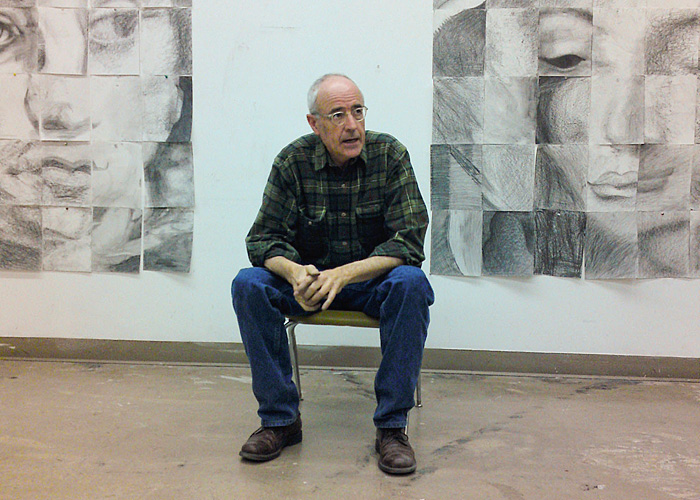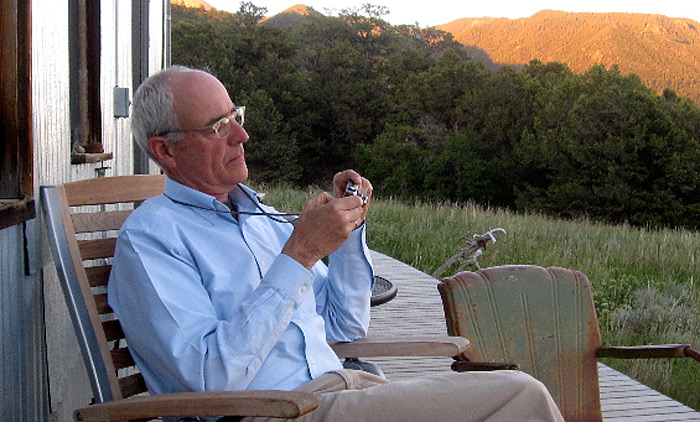About Robert Spellman

Photo: Cynthia Pagaduan-Ignacio
Choosing work for this website has been a combination of rummaging around through piles of images from the past and fussing with things completed just last week. It is always gratifying to discover something from three decades ago that still looks good. It is also a relief (for both you and me) that you can't see all the sidetracks, missed boats, and bombs that pile up around any working artist.
I decided to pursue art study while in high school in Shrewsbury, Massachusetts. My art teacher, Joseph Deignan, encouraged me to apply to art school in Boston. I realized only much later how much Mr. Deignan altered the direction of my life. (Some of our most important teachers can be quite influential without our knowing at the time.) In this case, he successfully prepared me to apply to Massachusetts College of Art in Boston, which was then and still is very competitive; you had to have your ducks in a row to get in.
•••
Mass Art was a good experience. I enjoyed being in a school entirely dedicated to the study of art. I wasn't exactly a crackerjack student and I probably missed a lot of important information. I did meet some very influential teachers. One was Arthur Hoener, who had studied with Hans Hoffman and Josef Albers. (Along with Timothy Leary, Ram Dass, and others, he had also been in on some of the early experiments with LSD and other hallucinogenic drugs; this was way before the onset of hippiedom.) Arthur Hoener was the first person to tell me about meditation. I still own the same copy of Zen Flesh, Zen Bones by Paul Reps that he recommended. I didn't know at the time that the practice of mindfulness meditation would become a central mode of inquiry for me. Among the many things that he taught, one was the practice of drawing Roman capital letters freehand. I remember his saying to me, “This is your kind of practice!” It wasn't until many years later that I began to understand that he was imparting a lifelong practice of looking, seeing, shaping, and honing. (And wasn't his name Hoener!) Some of my other teachers were Robert Moore and Jeremy Foss in painting – both of whom embodied art as its own form of wisdom; and a brilliant design teacher named Lew Fifield. Phyllis Bretholz taught an inspired course in African Art; she was very influential in pushing many of us beyond the embarrassing limitations of a Eurocentric view of culture. I was also permanently expanded by John Thorntons's Philosophy of Art class. During my MassArt years I also had an influential apprenticeship with the photographer Vincent Varvaro, who demonstrated qualities of precision and patience that influence me still.
After graduating in 1972, I continued to live in Boston where I became one of the denizens of the old warehouse district around South Station in its last days before construction of the Federal Reserve Bank and other urban renewal projects. I worked at a display company under another very influential mentor named Ken Hartman, whose instruction was so skilled I didn't even recognize it as life-changing until years later. It was during this time that I met my future wife, Joan Anderson, who is an artist herself and an influential friend and guide. During these same years I resumed the study of music, an avocation since elementary school.
•••
In the late 1970s I came into contact with Chögyam Trungpa Rinpoche, an unconventional and deeply penetrating teacher and artist who had fled the Chinese Communist invasion of Tibet. Under his guidance I became involved in the study and practice of Buddhist meditation and philosophy. Joan and I left Boston in 1985 to take jobs as caretakers at a rural retreat center in southern Colorado called Dorje Khyung Dzong. This was a job we took sight unseen; I guess we were keen on getting out of Boston. The shift from urban east coast to rural – very rural – Colorado was extreme. And welcome. The Huerfano valley, in one of the most sparsely populated and ruggedly beautiful counties in the state, turned out to be a very colorful neighborhood of artists, musicians, Hispanic ranchers, past and present hippies, and people who took quite seriously the nineteen-sixties era notion of dropping out . We stayed there for six years.

Photo: Michael Shannon Moore
In 1991 we moved to Boulder, Colorado, to take administrative jobs in the Buddhist organization founded by Chögyam Trungpa; and later to begin teaching at The Naropa Institute, now Naropa University. I was Chair of the visual arts department from 1996 until 2003. I continued to teach there in the visual arts, contemporary perfomance, and religious studies departments until I retired as full professor in 2018.
•••
In 1996 Joan and I purchased land in southern Colorado in the Huerfano valley not far from the retreat center we had managed. We call this land “Mountain Water”. Thanks to much encouragement and support from friends, family, and students we now have a place for artists to practice sitting meditation and visual and verbal arts. The cumulative experience of living at Dorje Khung Dzong, where it was easy to practice both painting and meditation, and years of teaching at Naropa and privately have produced a trove of experiential knowledge about artistic practice. Mountain Water is where we practice and teach this. Read more about developments at Mountain Water.
— Robert Spellman
